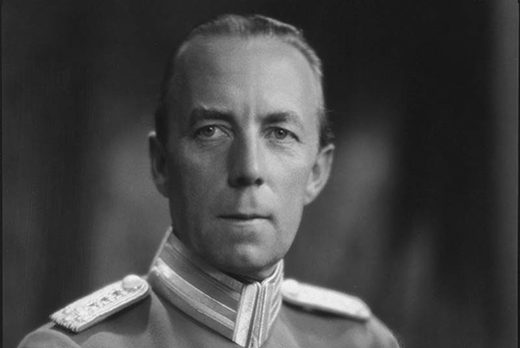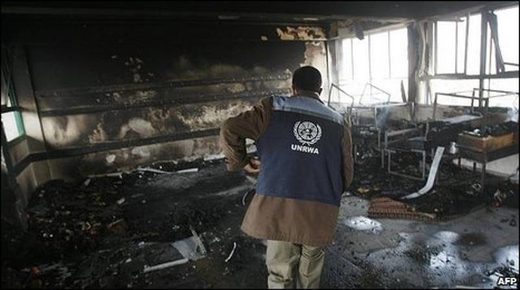
The United Nations sits on First Avenue, just off of 41st Street, overlooking the East River in New York City. It opened to great applause and expectation. A wishful answer to the madness that had become a world unleashed with the scent of blood and the all too customary wail of mourn.
It was to be our collective hope. A grand oath by which, together, the world could find answers to the greed and arrogance of states long unbound in their historical feed upon those less powerful. It has not worked.
Founded in San Francisco on October 24, 1945, the UN opened with endless promise. As proclaimed in its lofty preamble, the original 51 member states committed themselves to saving "succeeding generations from the scourge of war ... [reaffirmed] ... faith in fundamental human rights, in the dignity and worth of the human person, in the equal rights ... of nation's large and small ... to establish conditions under which justice and respect for the obligations arising from ... international law [could] be maintained ... to ensure... that armed force [would] not be used, save in the common interest."
With all too comfortable ease, 73 years later, these passionate words of humanity have once again proven themselves to be little more than idle chatter in which the powerful not only craft the tone of the debate, but set about to ensure its content reflects their unique and predatory vision of the rule of law.
In what has become a political art form of pain and punishment, with repeated rerun a handful of powers have used their veto to ensure that the Security Council (UNSC), the UN's most empowered organ, is long on vent, but short on action.
In first place stands Russia/Soviet Union which has used its veto 112 times- more than any other permanent member of the UNSC. Most recently, on April 10, 2018, Russia blocked a resolution to identify who was responsible for the alleged chemical weapons attack in Douma in Syria. To date, since the conflict began in 2011, Russia has used its veto 12 times regarding Syria. Earlier, it vetoed a Security Council condemnation of its annexation of Crimea in 2014.
In second place stands the United States. It has exercised its veto power some 80 times to date. Since 1982, the grand protector of Israel has vetoed 36 UNSC resolutions critical of it, more than the total number of vetoes cast by all the other UNSC members.
Most recently, it vetoed a resolution proposed by Kuwait condemning Israeli attacks upon thousands of Palestinians during the Great March of Return that called for an independent investigation into mass killings and injuries that have ensued. On December 18, 2017, it vetoed a draft resolution approved by 14 of the 15 members of the Security Council urging countries to refrain from establishing embassies in Jerusalem.
In its most basic form, the veto power ensures that permanent members of the UNSC can, as they choose, prevent any collective UN action whether a diplomatic or armed response to an international crisis, thus sacrificing the will of the world community to their own narrow geopolitical programme.
UN inaction, or sanctioned violence, has long betrayed any meaningful effort to serve as the world's neutral arbiter to ensure equal and just application of international law and the pursuit of world peace.
While examples of meaningless, indeed failed, political debate abound, one, in particular, exposes the UN as little more than an excuse for yearly September get-togethers of world leaders.
No state has offended, with such brazen regularity and uniform betrayal, the core principles of the UN than has Israel, established on stolen Palestinian land.
Decades of ethnic cleansing in Palestine
Since literally its first day, when the UN announced to the world that Palestine was relegated to history and Israel crafted as a Middle East extension of Europe, this state has flouted international law in its march of ethnic cleansing.
With mayhem its mantra even before its artificial declaration of statehood, Israel's Zionist framers never blinked at the use of unbridled terror to obtain their goal. The bombing of the King David Hotel, in 1946, by the Irgun, a UK-designated terrorist organisation, took the life of 91 mostly civilians.
While this massacre and the assassination of UN mediator Folke Bernadotte, in Jerusalem in 1948, by the group Lehi, momentarily captured the eye of the world, little was known about the decade of horror that both Palestinians and British had lived at the hands of Zionist militias.
During this period, Palestinians and British police and military personnel were injured or assassinated by explosives, snipers or lynching. Jewish terrorists attacked infrastructure, en masse, as they robbed banks and bombed military and police installations, government offices, and ships. They sabotaged railways, bridges, and oil installations using booby traps, ambushes and vehicle blasts with the kind of cold detached execution that the world would once again see just this past month not from the Irgun, but from its heir - the Israeli military.
There is no need to recast, in full, the nightmare that has befallen tens of thousands of unarmed Palestinian demonstrators over the last several weeks in Gaza, leaving 45 dead and thousands injured. By now, the massacre has been well recorded.
Not surprisingly, most killed or injured suffered gunshot wounds to the rear of their heads or backs. In the parlance of forensic science, these entry wounds are consistent not with attack but flight.
Civilian massacres are, of course, very much an essential part of the Israeli historical narrative. A walk down its memory lane shows an unbroken pattern of carnage perpetrated upon the most vulnerable of its enemies, real or imagined.
The 2008-2009 war on Gaza
In the winter of 2008-2009, Israel launched a massive assault on Gaza. Within the first 9 hours, it dropped more than 100 tonnes of explosives on the strip.
In the days to come, tens of thousands of its civilians were exposed to white phosphorous shells fired into crowded residential areas, not as incidental cover to otherwise legitimate use of force, but rather as a primary weapon of war in violation of international law.
Such shells struck the main Gaza compound of the United Nations Relief and Works Agency (UNRWA) where some 700 civilians had taken shelter, causing numerous deaths and injuries.
On the day before the hostilities ended, three phosphorous shells landed in another clearly marked UN facility, one of which setting a classroom on fire and killing two brothers as they slept. As with all other UN facilities, Israel had advance notice of its coordinates.
White phosphorus produces horrific burns. It sticks to the skin of its victims, penetrating their bodies resulting in liver, heart and kidney damage and, in some cases, multiple organ failures. White phosphorus burns unless deprived of oxygen or until it is completely exhausted.
Throughout the attack, Israel fired some 7,000 dual-purpose improved "conventional" artillery shell designed to avoid international prohibitions against the use of traditional cluster bombs.
Intended as an anti-armour and antipersonnel weapon, each artillery shell explodes into hundreds of smaller fragments within a 100m radius, killing and wounding indiscriminately. One example of their destructive potential was a January 6 attack near an UNRWA school in Jabaliya, which killed 43 Palestinians. On that occasion, Israel acknowledged the use of the shells.
The UN Fact-Finding Mission on the Gaza Conflict ruled that these attacks constituted violations of international human rights and humanitarian law as well as possible war crimes and crimes against humanity. The Israeli assault killed some 1,400 Palestinian men and women, including hundreds of children.
South African Jurist Richard Goldstone, a former international war crimes prosecutor and member of the UN team that issued the report, described the Israeli conduct as "a deliberately disproportionate attack designed to punish, humiliate and terrorize a civilian population, radically diminish its local economic capacity both to work and to provide for itself, and to force upon it an ever increasing sense of dependency and vulnerability."
With the Obama administration taking the lead in defence of Israel, the UN took no steps to hold it accountable for repeated violations of international law during the massacre.
The 2014 war on Gaza
Five years later, Israel struck once again as it launched another war on Gaza with massively disproportionate force.
According to a UN report, "the scale of the devastation was unprecedented" with more than 6,000 air strikes and 14,500 tank shells and 35,000 artillery shells fired.
Many of these explosive devices were used in densely populated areas and designed to have a "wide-area" impact to ensure that anyone or anything within the contact area would likely be killed, injured or damaged due to their explosive power and imprecision.
One non-governmental organisation reported a 533-percent increase in the use of highly explosive artillery shells in comparison to the previous Israeli assault on Gaza.
As noted by the UN, haphazard strikes in densely populated neighbourhoods, on residential buildings, the use of explosives with wide-area effects and the destruction of entire neighbourhoods in Gaza likely constituted a violation of the prohibitions of indiscriminate attacks against civilians and was, therefore, a war crime.
When Israel's thirst for retribution was at last satisfied, 2,256 Palestinians were killed, the majority of them civilians, including 538 children and 308 women. More than 11,000 others were wounded, a third of them children, with over 1,000 left permanently disabled.

Criminal not just for the loss of life, the concentrated Israeli onslaught was designed to cause lasting devastation on a community already overwhelmed by poverty and still reeling from the last major assault on its infrastructure just a few years earlier.
The Israeli army damaged or destroyed 235 schools and 73 health centers. Thousands of homes, hundreds of factories and farms were totally levelled. The lone power station and a major sewage pipe in Gaza were destroyed.
Approximately six weeks after Israel launched its assault, the Human Rights Council of the UN held an emergency session regarding the bloodbath in Gaza.
In the strongest of terms, a resolution was passed which, in relevant part, condemned
"the widespread, systematic and gross violations of international human rights and fundamental freedoms arising from ... the latest Israeli military assault on the occupied Gaza Strip, by air, land and sea, which has involved disproportionate and indiscriminate attacks, including aerial bombardment of civilian areas, the targeting of civilians and civilian properties in collective punishment contrary to international law and other actions, including the targeting of medical and humanitarian personnel, that may amount to international crimes."Though the resolution called for an immediate ceasefire, predictably, it was ignored by Israel. Only one country voted against the resolution - the United States.
Although an investigation into the massacre of 2014 is currently under way at the International Criminal Court, to date, the UN itself has undertaken no affirmative steps nor imposed any sanctions against Israel.
Part 2

Throughout its 70 years of existence, Israel has not sought to limit its breach of international law and the law of war to Palestine. In fact, it has a long and well-documented history of human rights violations and war crimes in Lebanon.
Here, too, the United Nations has watched largely in silence as Israel has targeted civilian communities and UN facilities, made use of prohibited weapons of war and participated in massacres against defenceless women and children.
The 1982 invasion
In 1982, the Israeli army invaded Lebanon under the pretext of responding to attacks by the Palestinian Liberation Organisation (PLO), which at the time, was headquartered in West Beirut. The Lebanese civil war provided convenient cover for Israeli violence directed at Lebanese and Palestinian civilians, alike.
In order to drive out the PLO, Israel unleashed a barbaric assault on Beirut by air and sea while cutting off food, water supply and electricity. During the two-month siege, Israel hit "five UN buildings, 134 embassies or diplomatic residences, six hospitals or clinics, one mental institute, the Central Bank, five hotels, the Red Cross, Lebanese and foreign media outlets, and innumerable private homes".
It is estimated that between June 6 and August 25 that year, the Israeli onslaught killed more than 17,000 Lebanese and Palestinians, most of them civilians. At the end of the month, the US President Ronald Reagan called the killings a "holocaust" in an angry phone call to the Israeli prime minister.
While much of the world watched the mass killing with horror, little action was undertaken to intervene. That encouraged the Israelis to go even further. A month after the evacuation of thousands of PLO fighters from Lebanon, the Israeli army occupied Beirut, encircling the Palestinian camps of Sabra and Shatila. On September 16, Christian Phalangists fighters, encouraged by the Israelis, descended on the camps torturing, raping, mutilating and murdering more than 3,000 Palestinian civilians, many of them women, children and elderly.
Late in 1982, the UN General Assembly declared the carnage an act of genocide, condemning Israel in the "strongest terms for the large-scale massacre of Palestinian civilians in the Sabra and Shatila refugee camps." However, neither the UN nor any other international body ever took action against Israel or its proxies for the massacre.
The Qana massacre
In 1985, Israel withdrew its forces to the so-called "security zone" in southern Lebanon, extending its military presence until 2000. For those 15 years, it continued launching deadly attacks on Lebanon and Lebanese civilians.
On April 18, 1996, the Israeli army targeted a UN compound in the village of Qana where some 800 civilians had sought shelter from Israeli bombardments during a battle with Hezbollah. More than a 100 civilians died and another 116 were injured in the assault on the clearly marked compound.
The UN expressed its condolences for civilian losses, took no further steps against Israel. Amnesty International described the attack in a report as a "callous disregard for civilian lives and a breach of the laws of war on directly or indiscriminately targeting civilians".
This is not to suggest that the United Nations was completely indifferent to the shelling of its compound as the General Assembly, by a vote of 66 to two with 59 abstentions, passed a resolution demanding that Israel reimburse it to the tune of $1.7m for the cost of repairs to its compound.
Predictably, the United States and Israel voted against the resolution and not surprisingly, the latter ignored the bill. The UN took no subsequent steps against Israel for its refusal.
The 2006 war

Israeli media reported that the Israeli military had used large numbers of banned weapons. One officer who participated in the war described the wholesale use of such weapons against civilians as "insane and monstrous".
According to him, the Israeli army fired around 1,800 cluster bombs containing over 1.2 million bomblets. Other soldiers described the wholesale use of banned phosphorous weapons as primary weapons of war.
On July 30, the Israeli army targeting a house in the village of Qana whether two extended families had sought shelter. The attack killed 54 civilians, 37 of them children.
While the Security Council expressed "extreme shock and distress" at the bombing and offered its condolences for the deaths, it took no further action against Israel for this atrocity.
On August 7, two missiles fired by an Israeli warplane destroyed and damaged apartment buildings in the Shiyyah suburb of Beirut. At least 60 people died. Later that same day, the Israeli army struck another building in the city of Ghaziyeh, killing 16 civilians.

A UN shared by the world
None of these atrocities is isolated in time and place, neither are they an historical anomaly. It is very much who we are and what we have become.
Long before the Sabra and Shatila massacre, Israel drove upwards of a million Palestinians from their ancestral homeland through conscious and determined ethnic cleansing, accompanied by rape, murder and arson. The history of Deir Yassin, Ramleh and Lydda is well known and documented.
Not much has changed in the decades since, as Israeli regulars have added Qibya, Rafah, Jenin, Beit Hanoun and other Palestinian communities to the ranks of those etched among the annals of uncharged and unprosecuted war crimes.
Elsewhere, today, in Myanmar, Syria, Kashmir and other warzones, rape, torture, forced displacement, carpet bombing, and prohibited chemicals continue to be the preferred weapons of war with civilians the prime targets.
It wasn't always that civilians were so systematically targeted. As a blog on the International Committee of the Red Cross website notes, the 1859 Battle of Solferino during the Second Italian War of Independence caused the death of 6,000 soldiers and only one civilian.
Since that time, we have seen the expansion of the law of war and the passage of the Convention for the Amelioration of the Wounded in Time of War which serves as the precursor to the Geneva Conventions.
Both hallmarks of international law were designed to safeguard people and property that did not contribute to warfare and to protect civilians and civilian communities from unnecessary destruction and hardship. Yet, despite evolving principles and efforts to insulate non-combatants from the horrors of war, now more than ever, they have become the prime victims of its intended death and destruction.
Indeed, according to UNICEF, during the 20th century, the proportion of civilian to military casualties has increased from 15 percent in World War I to 65 percent in World War II to 90 percent in the conflicts over the last few decades. Most civilian casualties are children and women.
Can it be mere coincidence that the dramatic increase in violence and civilian casualties parallel the establishment and growth of the United Nations?
Does the fact that five permanent members of the Security Council ultimately dictate where and when the UN acts with independence and certainty all but guarantee that it will never be more than a political playground dominated by the few as they pursue their own unique partisan agenda?
In 2018, it is simply not enough to issue press releases or pound the speaker's podium, exalting lofty UN ideals to those foolish enough to buy the sale. Toothless resolutions condemning war crimes, crimes against humanity or violations of any of the other hundreds of UN covenants and prohibitions remain but a tease unless and until that world body acts with resolve to ensure international promise and equal application of law become reality.
It is long past time to permit a world body to be shared equally by a world community.
For more than seven decades, the hallways of the UN have served as exciting field trips for young students and world visitors. I know - I was one.
Awed by the majesty of the General Assembly, with its impressive French murals, green marble desks, matching lecterns and UN emblem on a gold backdrop, tourists escape the reality of the moment with an inspiring recorded narrative of its accomplishments.
Yet, in real time, in real places, hundreds of millions of the world's poorest, most frail, and vulnerable pay the price daily for the hollow promise that is the UN.
Stanley L Cohen is a US-based attorney and human rights activist who has done extensive work in the Middle East and Africa. He has handled prominent international cases including that of Hamas leader Mousa Abu Marzook. He has served as a consultant to Middle East governments and movements including Hamas and Hezbollah and NGOs and foundations in Palestine, Egypt, Syria, Lebanon, Saudi Arabia and Turkey.





Reader Comments
to our Newsletter